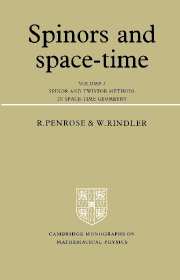6 - Twistors
Published online by Cambridge University Press: 23 December 2009
Summary
The twistor equation and its solution space
At various places in Volume 1 we stressed the fact that the two-component spinor calculus is a very specific calculus for studying the structure of space–time manifolds. Indeed, the four-dimensionality and (+ - - -) signature of space–time, together with the desirable global properties of orientability, time-orientability, and existence of spin structure, may all, in a sense, be regarded as derived from two-component spinors, rather than just given. However, at this stage there is still only a limited sense in which these properties can be so regarded, because the manifold of space–time points itself has to be given beforehand, even though the nature of this manifold is somewhat restricted by its having to admit the appropriate kind of spinor structure. If we were to attempt to take totally seriously the philosophy that all the space–time concepts are to be derived from more primitive spinorial ones, then we would have to find some way in which the space–time points themselves can be regarded as derived objects.
Spinor algebra by itself is not rich enough to achieve this, but a certain extension of spinor algebra, namely twistor algebra, can indeed be taken as more primitive than space–time itself. Moreover, it is possible to use twistors to build up other physical concepts directly, without the need to pass through the intermediary of space–time points.
- Type
- Chapter
- Information
- Spinors and Space-Time , pp. 43 - 168Publisher: Cambridge University PressPrint publication year: 1986



